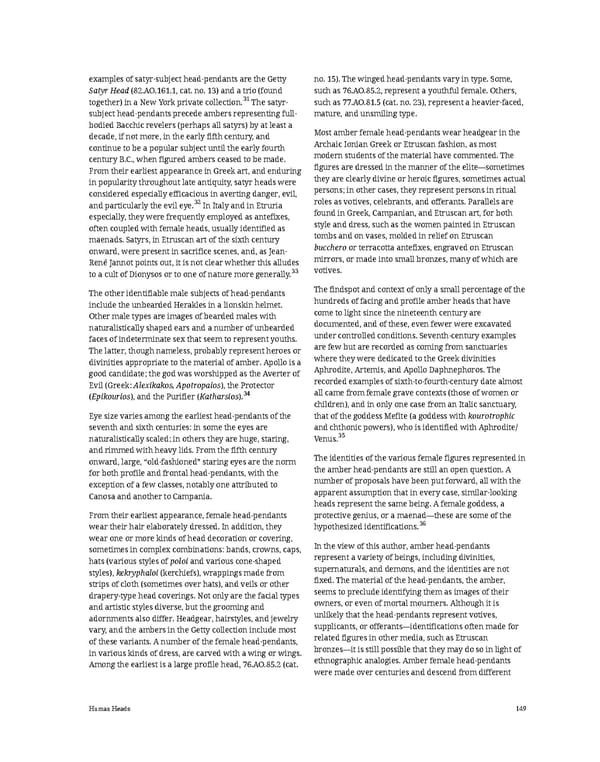examples of satyr-subject head-pendants are the Getty no. 15). The winged head-pendants vary in type. Some, Satyr Head (82.AO.161.1, cat. no. 13) and a trio (found such as 76.AO.85.2, represent a youthful female. Others, together) in a New York private collection.31 The satyr- such as 77.AO.81.5 (cat. no. 23), represent a heavier-faced, subject head-pendants precede ambers representing full- mature, and unsmiling type. bodied Bacchic revelers (perhaps all satyrs) by at least a decade, if not more, in the early fifth century, and Most amber female head-pendants wear headgear in the continue to be a popular subject until the early fourth Archaic Ionian Greek or Etruscan fashion, as most century B.C., when figured ambers ceased to be made. modern students of the material have commented. The From their earliest appearance in Greek art, and enduring figures are dressed in the manner of the elite—sometimes in popularity throughout late antiquity, satyr heads were they are clearly divine or heroic figures, sometimes actual considered especially efficacious in averting danger, evil, persons; in other cases, they represent persons in ritual and particularly the evil eye.32 In Italy and in Etruria roles as votives, celebrants, and offerants. Parallels are especially, they were frequently employed as antefixes, found in Greek, Campanian, and Etruscan art, for both often coupled with female heads, usually identified as style and dress, such as the women painted in Etruscan maenads. Satyrs, in Etruscan art of the sixth century tombs and on vases, molded in relief on Etruscan onward, were present in sacrifice scenes, and, as Jean- buccheroor terracotta antefixes, engraved on Etruscan René Jannot points out, it is not clear whether this alludes mirrors, or made into small bronzes, many of which are to a cult of Dionysos or to one of nature more generally.33 votives. The other identifiable male subjects of head-pendants The findspot and context of only a small percentage of the include the unbearded Herakles in a lionskin helmet. hundreds of facing and profile amber heads that have Other male types are images of bearded males with come to light since the nineteenth century are naturalistically shaped ears and a number of unbearded documented, and of these, even fewer were excavated faces of indeterminate sex that seem to represent youths. under controlled conditions. Seventh-century examples The latter, though nameless, probably represent heroes or are few but are recorded as coming from sanctuaries divinities appropriate to the material of amber. Apollo is a where they were dedicated to the Greek divinities good candidate; the god was worshipped as the Averter of Aphrodite, Artemis, and Apollo Daphnephoros. The Evil (Greek: Alexikakos, Apotropaios), the Protector recorded examples of sixth-to-fourth-century date almost (Epikourios), and the Purifier (Katharsios).34 all came from female grave contexts (those of women or children), and in only one case from an Italic sanctuary, Eye size varies among the earliest head-pendants of the that of the goddess Mefite (a goddess with kourotrophic seventh and sixth centuries: in some the eyes are and chthonic powers), who is identified with Aphrodite/ naturalistically scaled; in others they are huge, staring, Venus.35 and rimmed with heavy lids. From the fifth century onward, large, “old-fashioned” staring eyes are the norm The identities of the various female figures represented in for both profile and frontal head-pendants, with the the amber head-pendants are still an open question. A exception of a few classes, notably one attributed to number of proposals have been put forward, all with the Canosa and another to Campania. apparent assumption that in every case, similar-looking heads represent the same being. A female goddess, a From their earliest appearance, female head-pendants protective genius, or a maenad—these are some of the wear their hair elaborately dressed. In addition, they hypothesized identifications.36 wear one or more kinds of head decoration or covering, sometimes in complex combinations: bands, crowns, caps, In the view of this author, amber head-pendants hats (various styles of poloi and various cone-shaped represent a variety of beings, including divinities, styles), kekryphaloi (kerchiefs), wrappings made from supernaturals, and demons, and the identities are not strips of cloth (sometimes over hats), and veils or other fixed. The material of the head-pendants, the amber, drapery-type head coverings. Not only are the facial types seems to preclude identifying them as images of their and artistic styles diverse, but the grooming and owners, or even of mortal mourners. Although it is adornments also differ. Headgear, hairstyles, and jewelry unlikely that the head-pendants represent votives, vary, and the ambers in the Getty collection include most supplicants, or offerants—identifications often made for of these variants. A number of the female head-pendants, related figures in other media, such as Etruscan in various kinds of dress, are carved with a wing or wings. bronzes—it is still possible that they may do so in light of Among the earliest is a large profile head, 76.AO.85.2 (cat. ethnographic analogies. Amber female head-pendants were made over centuries and descend from different Human Heads 149
 Ancient Carved Ambers in the J. Paul Getty Museum Page 158 Page 160
Ancient Carved Ambers in the J. Paul Getty Museum Page 158 Page 160